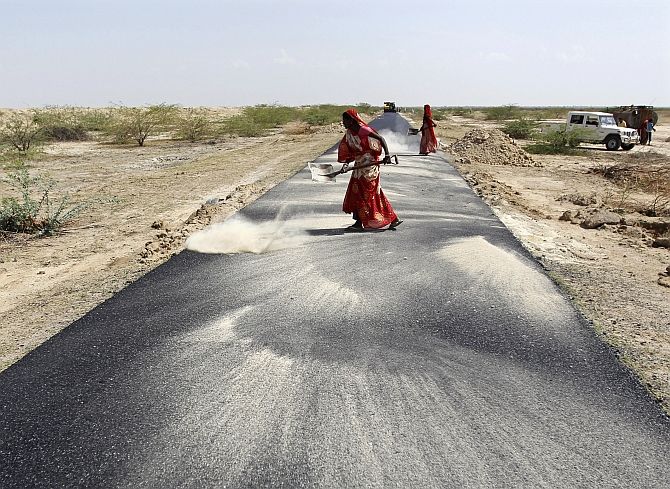
The euphoria of Ab Ki Baar Modi Sarkar will fade quickly if the Modi government does not raise its game, and focus significant monetary resources and managerial skills on making India’s infrastructure truly world-class, says Ram Kelkar.
As India gears up to honour its pravasis on January 9 to mark their contribution in the nation’s development, Rediff.com presents perspectives from eminent writers on the Diaspora.
Earlier in this series:
A look back in anxiety
The coup that changed India's Diaspora policy
Friends of India
The India I want to see
'India has stayed in my blood'
Bharat Mata and her children
The forgotten souls of India
The Modi Sarkar era is off to a promising start.
For someone who was an outsider to New Delhi and its inbred political culture, Modi has taken control of India’s administrative apparatus with gusto.
A Prime Minister’s Office-centric hands-on approach to governance has taken the reins of power over from the bureaucracy.
As Modi pointed out -- much to the merriment of the crowd at Madison Square Garden last September -- secretaries and other senior babus are actually showing up to work on time, while at the same time feeling empowered that the PMO will have their back for decisions they take without fear of being overridden.
The results of a focus on ‘Minimum Government and Maximum Governance’ are already evident. Arcane committees like the Group of Ministers and Empowered Group of Ministers, set up by the Manmohan Singh government, have been disbanded.
The decision-making process at the ministerial level has been speeded up and there is greater accountability in the system. There is a concerted focus on moving India up in the ‘ease of doing business’ rankings, with measures like streamlined approval processes and single-window clearance procedures.
The list goes on and on, as demonstrated by the speed with which the Modi government is focusing on reforms in the coal and power sectors, liberalisation of Foreign Direct Investment in defence, railways, real estate and insurance, and the recent agreement with the states on a nationwide Goods and Services Tax.
The stock markets have been on a tear and 2014 likely ended the record books with the best gains in five years.
It is said that well begun is half done, and in that sense the Modi government has achieved a lot already.
And yet the real challenge is to translate good governance and good intentions into good results.
Among the biggest challenges that India faces -- if it truly wants to join the ranks of advanced nations -- is the abysmal state of its infrastructure.
The ‘Make in India’ initiatives will go nowhere if domestic and international companies cannot get reliable power and drivable roads for the manufacturing sector growth that Modi wants for India.
Futuristic proposals like high-speed rail and ‘smart cities’ are well and good, but the need of the hour is basic infrastructure, including good roads and reliable power.
For NRIs, every visit to India is a reminder of how much more needs to be done.
The typical defensive reaction from family and friends in India is to point to a handful of highly visible success stories such as the new airport in Mumbai or the New Delhi Metro.
Comparing a few trophy projects in India to infrastructure in the US, Europe or China can lead to a false equivalence about the situation in India versus other countries.
The truth of the matter is that the airport in any small town in the US, and the interstate roads and ramps around the airport, are almost as good and modern as any major city in the US.
In contrast, road and airport infrastructure quality in India literally falls off a cliff outside of the major metro areas.
Most roads and airports are not world class even in the major metros in the first place.
The challenge to fix India’s impassable roads, inefficient ports, and inadequate power supply needs to be addressed on a war footing. India’s infrastructure ranked 85th out of 144 countries in the World Economic Forum’s most recent Global Competitiveness Report.
If India does not focus on improving its infrastructure, it risks falling further behind China as well as other emerging Asian countries such as Malaysia, Indonesia, Sri Lanka and Thailand which already have better infrastructure, and are likely to continue to develop their infrastructure at a faster rate than India.
 India’s
India’s
inability to build good infrastructure stems first and foremost from a shortage of adequate investment.
In addition, other key factors include an unwillingness to use the most efficient mechanised means for construction, regulatory over-reach for environmental protection, and endless delays from lawsuits and Public Interest Litigation that gum up the works.
A recent comment by Reserve Bank of India Governor Raghuram Rajan that India ‘… shouldn’t over-invest in the infrastructure sector’ is very puzzling and worrisome, since India is under-investing in this area in a significant way.
While China invested 8.5 percent of its GDP investing in infrastructure from 1992 to 2011, according to the McKinsey Global Institute, the norm for India and other developing countries was two to four percent of GDP.
According to World Bank research, India had 6,000 km of four-lane highways in 2009 whereas China built 35,000 km of four to six-lane highways during just the past 10 years, and over 630,000 km of two or more lane highways during the past five years.
The situation is equally appalling for electricity generation, with most of India having access to an erratic supply of electricity, and as many as 350 million Indians not having access to electricity at all.
China meanwhile has ensured that over 99 percent of its population has access to electricity. While Indian GDP has been growing at around eight percent in recent years, electricity generation has only increased at 4.9 percent a year, according to the World Bank.
Power generation facilities have sub-optimal scale in many instances because of jurisdictional conflicts, with each state electricity board focusing on its own narrow vision and mandate.
The national transmission grid is in dire need of investment, and distribution companies are financially insolvent. The massive electric grid failures in recent years that deprived almost 650 million people of electricity for days in northern India is a reminder of the challenges India faces in this area.
As for highways and roadways, Indian road construction is still typically done using manual labour instead of modern mechanised technology.
Using modern construction equipment can reduce project completion time significantly.
The Indian Construction Equipment Manufacturers Association estimates that manual concrete mixing only averages 20 cubic metres of concrete per day vs 18 cubic metres per hour using mechanised equipment.
That is a seven-fold increase in efficiency, which can speed up road construction significantly.
ICEMA also points out that since construction projects are generally awarded to the lowest bidder with little emphasis on quality and timeliness, contractors do not see any point in investing in construction equipment, and generally opt for the cheapest cost route typically using manual labour.
Insisting on the use of manual labour to save costs or in the name of job creation is in the end a job destroyer, since projects face interminable delays, and the manufacturers who could use those roads to create jobs will get discouraged and go elsewhere.
China and other fast growing nations in Asia such as Indonesia, Thailand and even Vietnam use state-of-the-art mechanised means to build infrastructure like roads and airports.
By sticking with outdated construction methods, India stands to fall behind in the race to attract manufacturing companies, which is one of Modi’s key goals.
During the tenure of the Manmohan Singh government, environmental regulations were widely perceived as being a major cause for delays in executing projects.
The widespread perception was that corrupt bureaucrats delayed approvals and required bribes to move projects forward. It is encouraging to note that the environment ministry in the Modi government has announced new policies to reduce the time lag for environmental clearances, and focused on making the process more transparent.
However, more needs to be done to reduce the procedural and legal roadblocks that hinder efficient and timely execution of infrastructure projects.
Prior to the 1980s, only an aggrieved party could approach the courts for justice, and the courts required locus standi for private litigation to move forward.
The Supreme Court changed the system such that any person or entity in civil society could approach the courts to seek legal remedies in cases where public interest was supposedly at stake.
While the intentions may have been noble and laudable, the practical result today is that PILs can indefinitely hold up road projects. Judicial reform is essential to ensure that PILs do not become a tool to fulfill private interests or settle political scores, leading to inordinate delays in legitimate and environmentally defensible infrastructure projects.
The euphoria of
Ab Ki Baar Modi Sarkar will fade quickly if the Modi government does not raise its game, and focus significant monetary resources and managerial skills on making India’s infrastructure truly world-class.
Complacence and hubris about how things are much better than they were in the 1960s and 1970s are dangerous.
And false parallels to the infrastructure challenges that other nations like the US face cannot be a panacea.
Build and they will come -- which is to say, the manufacturers and global investors bearing FDI and creating jobs. Maintain the status quo, and India’s growth miracle could wither on the vine.
Ram Kelkar is a Chicago-based writer.
Image: A road under construction in Bharadva village, Gujarat. Photograph: Amit Dave/Reuters.


 India’s
India’s